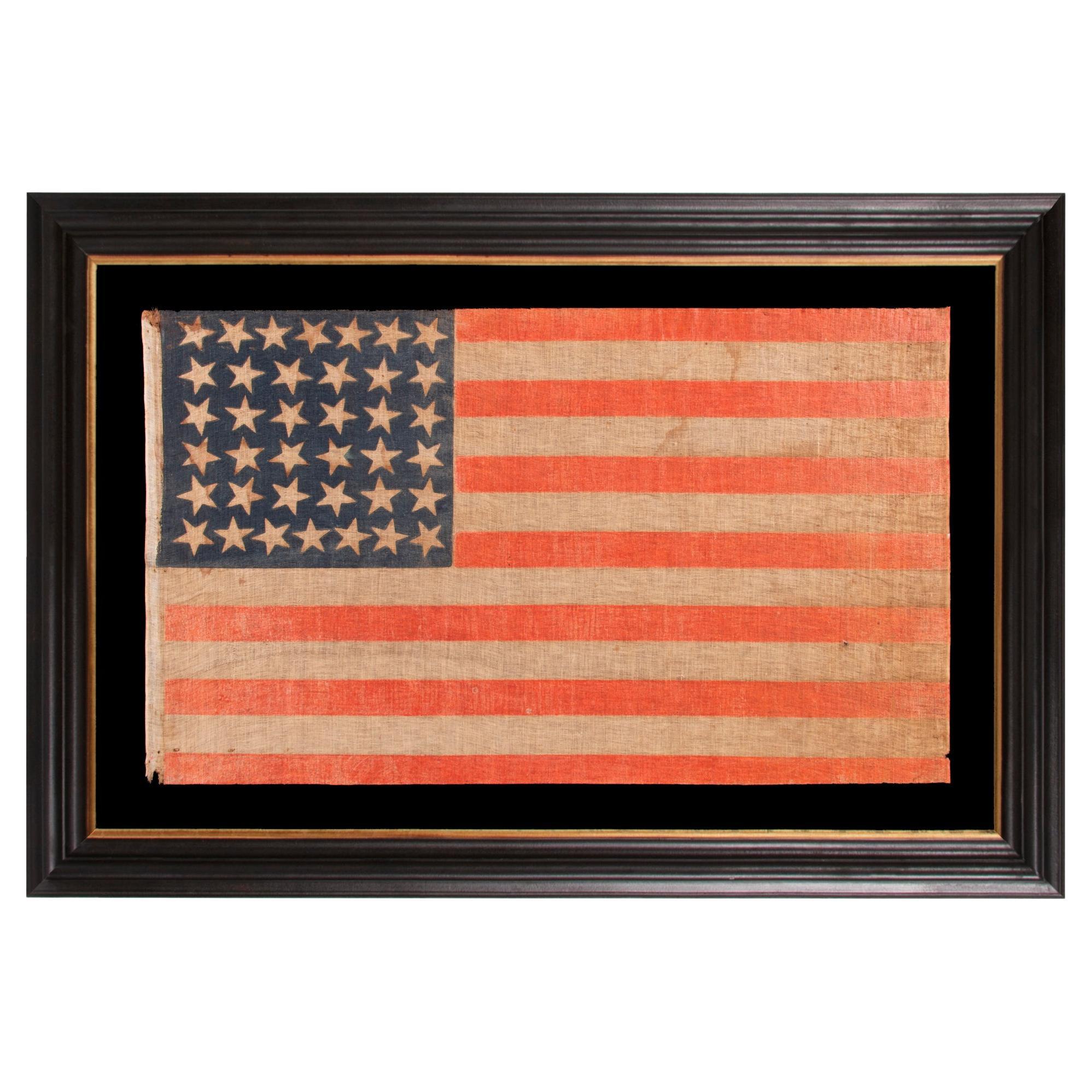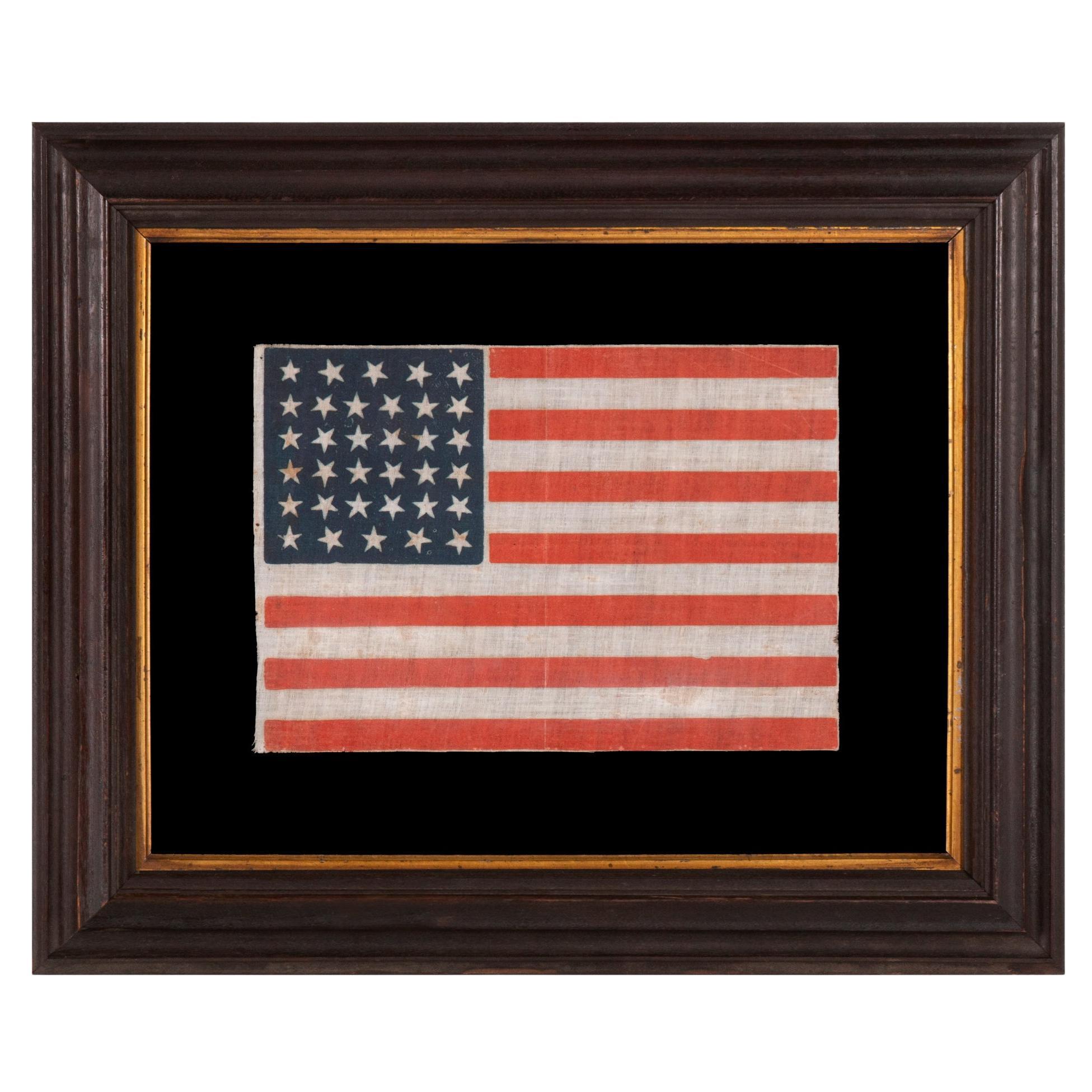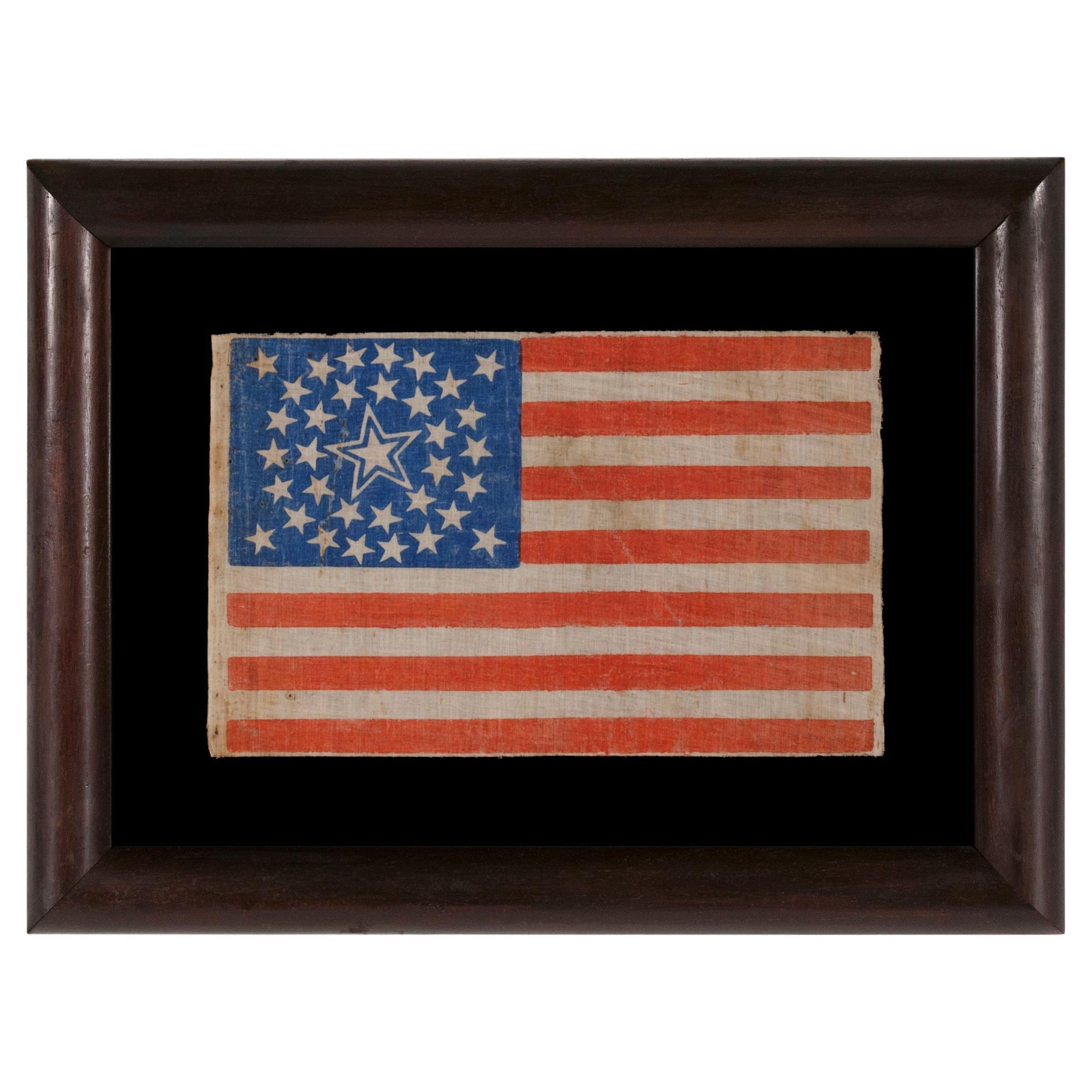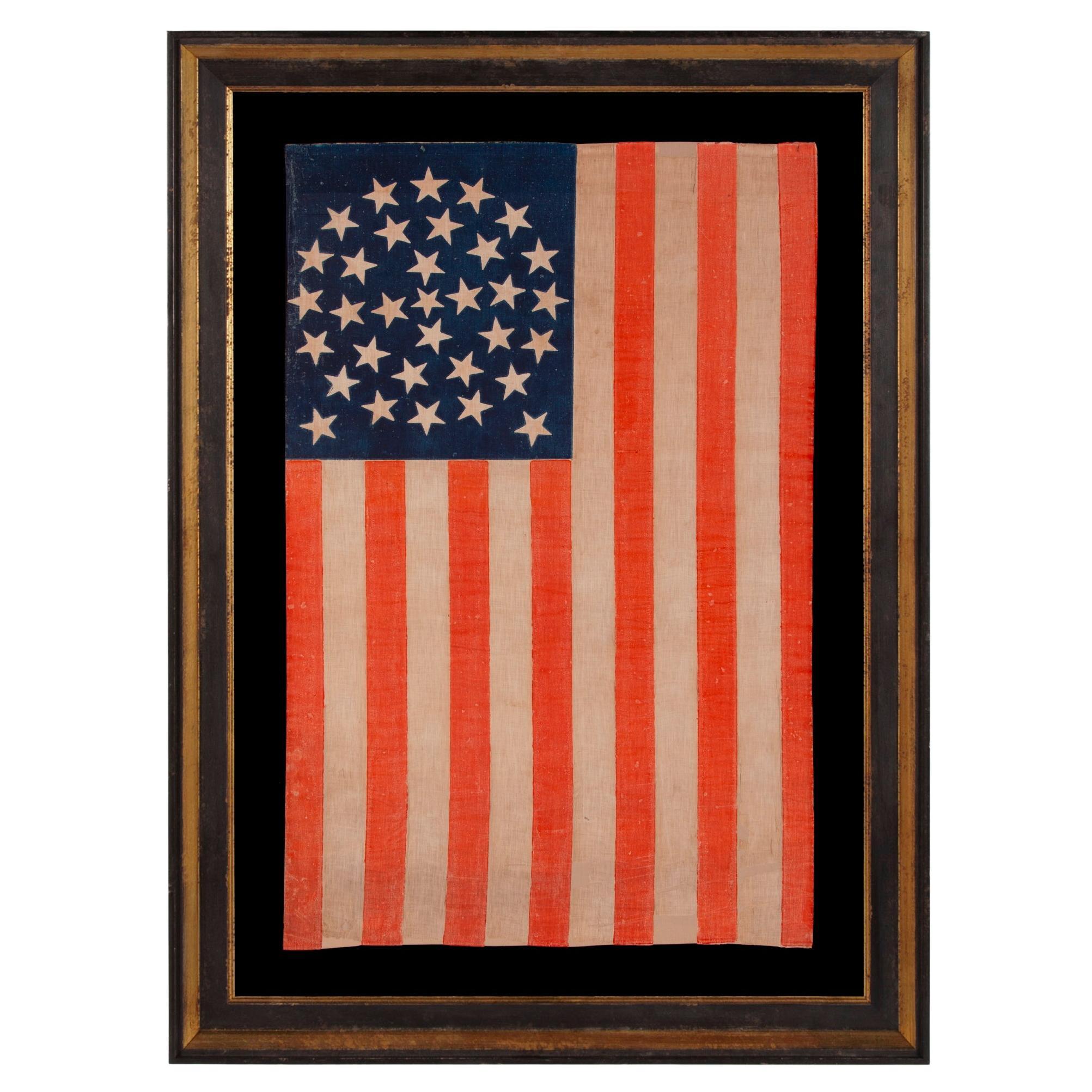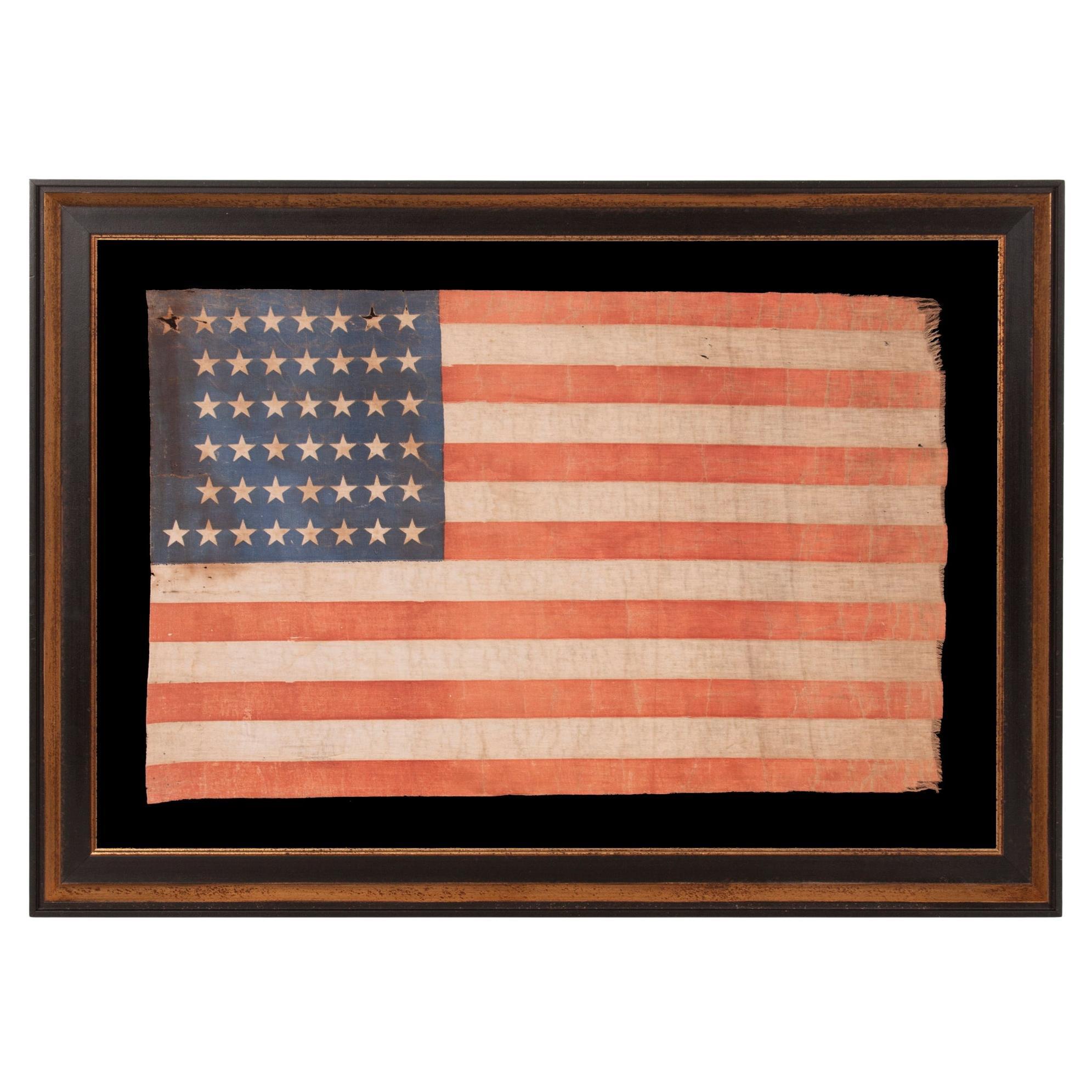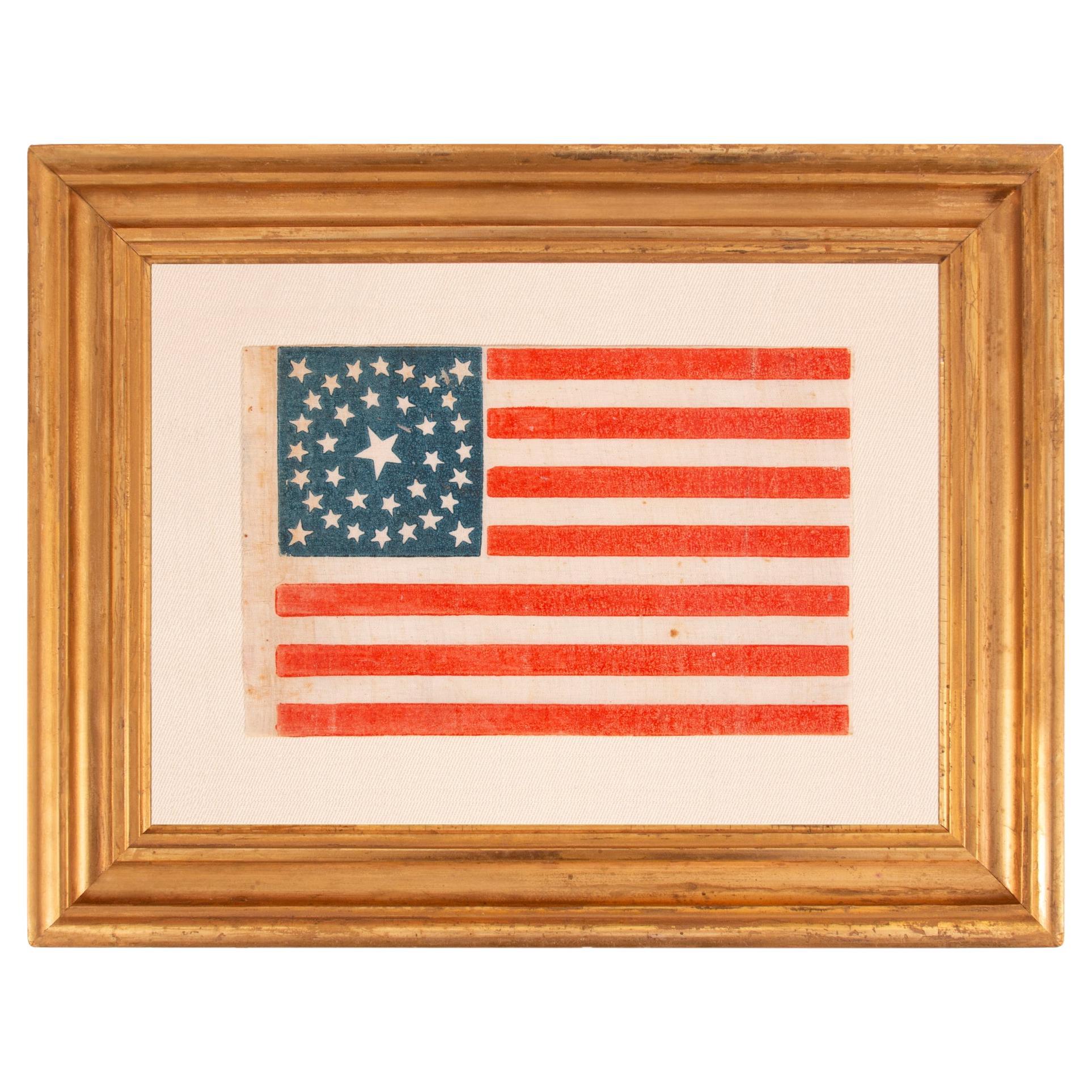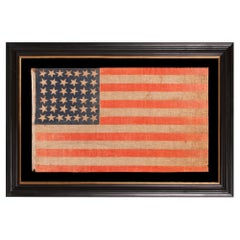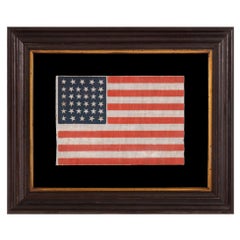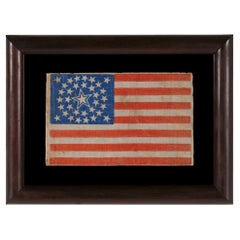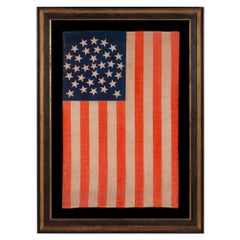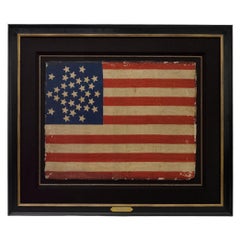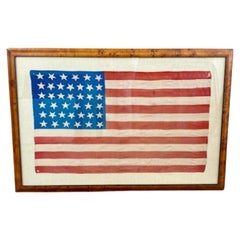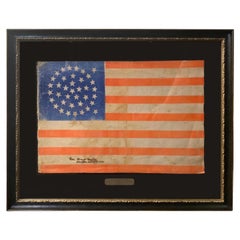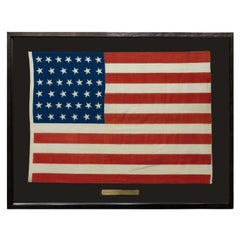Items Similar to 30 Star Antique American Parade Flag, Wisconsin Statehood, ca 1848-1850
Want more images or videos?
Request additional images or videos from the seller
1 of 7
30 Star Antique American Parade Flag, Wisconsin Statehood, ca 1848-1850
Price Upon Request
Price Upon Request
Price Upon Request
Price Upon Request
Price Upon Request
Price Upon Request
Price Upon Request
Price Upon Request
Price Upon Request
Price Upon Request
About the Item
ANTIQUE AMERICAN PARADE FLAG WITH 30 STARS, THE ONLY KNOWN EXAMPLE IN THIS SIMPLE BUT EXTRAORDINARY STYLE, PRE-CIVIL WAR, OFFICIAL FOR JUST TWO YEARS, REFLECTS THE ADDITION OF WISCONSIN AS THE 30th STATE, 1848-1850; ILLUSTRATED IN “THE STARS & THE STRIPES, FABRIC OF THE AMERICAN SPIRIT” BY J. RICHARD PIERCE
30 star American national parade flag, block-printed on fine cotton, possibly with some flax content. The only known example in this style, its stars are arranged in 5 neatly justified rows of 6, each with a single point directed upward. Though not dynamically configured and seemingly innocuous by description—traits I would not ordinarily be drawn to—from the moment I first picked up this exemplary flag, more than 20 years ago, I have remained unwaveringly enamored, not only of its unique status among identified examples in this rare star count, in which only three variations of printed parade flags have thus-far been discovered, but even more so of how beautiful and visually peculiar this flag is among the precious, surviving examples of the pre-Civil War era.
Chief among the factors contributing to why this flag is so special are traces of the lustrous, glazed surface of the white fabric throughout, on which it was printed with beautiful matte shades of Prussian blue and tomato red. Also of great interest are the flag’s very unusual margins. Though the original amount of white fabric present above and below this flag cannot be known, presumably separating it from others on the original bolt, the amount of open area to the left and right, between the printed region and the selvedge edges, is extraordinary. Although this circumstance, with so much open space, is rarely ever encountered in parade flags of any period, it is keenly notable here, especially given the flag’s early date, when waste of this nature would have routinely been avoided, especially when the fly end could be bound by hand-stitching, as-is the case here. The presence of this feature may in itself be testament to an extremely small run of production, the printer having made do with whatever fabric was available, perhaps too meet a deadline for a buyer who commissioned them, or in the face of availability of fabric in the correct scale, maybe in some far-flung location.
Even if the extra fabric had no foreseeable use in the near future, in almost all instances the extra would have been saved by aligning the fly end close to the selvedge and trimming along the hoist, with a small allowance for hemming. Whatever the case may be, the margins are far greater than I have ever seen, though at the same time surprisingly attractive, particularly with the knowledge of both historical context and just how unordinary it is, compounded by the fact that this is, presently, the only one known. Further evidence of this having been the work of someone who may not have regularly made few flags is evident around the perimeter of the blue pigment, including the interior of the stars, where oil or some other binder seeped into the cotton and caused a taupe-colored halo. Regular use of this pigment by a printer seems unlikely.
Wisconsin joined the Union as the 30th state on May 29th, 1848, and the 30th star was officially added on July 4th of that year. Although this remained the official count until July 3rd, 1851, flags in this star count would not have produced following the addition of California on September 9th, 1850. Flag-makers, both commercial and otherwise, paid little heed to official star counts, instead selecting what was practical. Sometimes a star might even be added before a new state came in, in hopeful anticipation. This meant that the 30 star flag had a realistic window of production of just over two years.
Flags made prior to the Civil War (1861-1865) are extremely rare, comprising less than one percent of 19th century flags that have survived into the 21st century. Prior to the Confederate attack on Fort Sumter, the Stars & Stripes was simply not used for most of the same purposes that we employ it in today. Private individuals did not typically display the flag in their yards and on their porches. Parade flags didn't often fly from carriages and horses. Places of business rarely hung flags in their windows. Private use of the national flag rose swiftly during the patriotism that accompanied the Civil War, then exploded in 1876 during the centennial of American independence.
Even the military did not use the flag in a manner that most people might think. The primary purpose before the Civil War was to mark ships on the open seas. While the flag was used to mark some garrisons, the flags of ground troops were often limited to the flag of their own regiment, with a design peculiar unto itself, and perhaps a standard that featured the numeric designation on a painted or embroidered streamer, on a solid buff yellow or blue ground. Most people are surprised to learn that ground forces were not authorized to carry the Stars & Stripes until well into the 19th century. It was first assigned to artillery regiments in 1834. Infantry was afforded the privilege in 1841, just prior to the Mexican War (1846-1848), while cavalry regiments were not authorized until 1862, the second year of the Civil War.
The first printed parade flags appeared between 1837 and 1845. The earliest display either 26 stars, to reflect the addition Michigan as the 26th state, or 13 stars, paying homage to the original 13 colonies and the birth of our nation. Made just shortly thereafter, this particular example falls among the earliest of all known printed flags.
Prior to 1861, the only regular non-military use of the flag seems to have been for political campaigning. The first parade flags that are datable to a specific year—adorned with corresponding text and/or images for the purpose of advertising—appeared in 1840, produced for the successful presidential campaign of Whig Party nominee William Henry Harrison. In spite of not bearing names, slogans, portraits, or some other political text or imagery, the most likely intent of this 30 star parade flag would have likewise been for display at a political parade or rally. The most likely year of production would be 1848, when Whigs Zachary Taylor & Millard Fillmore defeated Democrats Lewis Cass & William Orlando Butler, as well as the independent, Free Soil Party ticket of former President Martin Van Buren and Charles Francis Adams, Sr. Provenance: Sold by Jeff R. Bridgman American Antiques in or around 2004 to collector Richard Pierce. This exact flag is documented on page 15 of "The Stars & The Stripes: Fabric of the American Spirit" by J. Richard Pierce (2005), which serves as the best available reference for parade flags specifically.
Mounting: For more than 25 years we have maintained a specialized department for this purpose. Our lead conservator holds a master's degree in textile conservation from one of the nation’s top university programs. We take great care in the mounting and preservation of flags and related textiles and have preserved thousands of examples.
The background is 100% cotton twill, black in color, that has been washed and treated for colorfastness. The mount was placed in a deep, cove-shaped molding with a very dark brown surface, nearly black, and a rope-style inner lip, to which a flat profile molding, with a finish like old gun metal, was added as a liner. The glazing is U.V. protective acrylic (Plexiglas). Feel free to contact us for more details.
Condition: There is minor to modest water staining in limited areas minor misprinting along the hoist end of the canton. There is some age toning throughout. Overall exceptional for the period, especially given its rarity.
Frame Size (H x L): 32.25" x 43.75"
Flag Size (H x L): 21" x 32.25"
- Dimensions:Height: 32.25 in (81.92 cm)Width: 43.75 in (111.13 cm)Depth: 2.5 in (6.35 cm)
- Materials and Techniques:
- Place of Origin:
- Period:
- Date of Manufacture:1848-1850
- Condition:
- Seller Location:York County, PA
- Reference Number:Seller: 30-0021stDibs: LU849744858552
About the Seller
5.0
Recognized Seller
These prestigious sellers are industry leaders and represent the highest echelon for item quality and design.
Established in 1991
1stDibs seller since 2008
70 sales on 1stDibs
Typical response time: 1 to 2 days
- ShippingRetrieving quote...Shipping from: York County, PA
- Return Policy
Authenticity Guarantee
In the unlikely event there’s an issue with an item’s authenticity, contact us within 1 year for a full refund. DetailsMoney-Back Guarantee
If your item is not as described, is damaged in transit, or does not arrive, contact us within 7 days for a full refund. Details24-Hour Cancellation
You have a 24-hour grace period in which to reconsider your purchase, with no questions asked.Vetted Professional Sellers
Our world-class sellers must adhere to strict standards for service and quality, maintaining the integrity of our listings.Price-Match Guarantee
If you find that a seller listed the same item for a lower price elsewhere, we’ll match it.Trusted Global Delivery
Our best-in-class carrier network provides specialized shipping options worldwide, including custom delivery.More From This Seller
View All38 Star Antique American Parade Flag, Colorado Statehood, ca 1876-1889
Located in York County, PA
38 STAR ANTIQUE AMERICAN PARADE FLAG WITH JUSTIFIED ROWS OF 7-6-6-6-6-7 AND SCATTERED STAR ORIENTATION, MADE DURING THE PERIOD WHEN COLORADO WAS THE MOST RECENT STATE TO JOIN THE UNION, 1876-1889
38 star American national parade flag, printed on coarse cotton, possibly with flax content. One of the flag’s most interesting features is the wild sweep of the grain of the fabric, the warp and weft of which are anything but perpendicular.
The stars are arranged in justified rows of 7-6-6-6-6-7. This results in a secondary pattern that I commonly call a “box-in-a-box-in-a-box”, because of the way in which the seemingly haphazard arrangement creates three consecutive squares. Note how the stars point in various directions on their vertical axis, which adds a nice element of folk quality to the overall design.
Most parade flags in this star count have red stripes that lean heavily toward orange, with a vibrant, chromatic luster. This was common across printed flags produced between the 1850's and the 38 star period, phasing out in the last decade of the 19th century. Also note how the wear and patina contribute to an endearing presentation that displays its long-term use gracefully.
Colorado became the 38th state on August 1st, 1876. This was the year of our nation’s 100-year anniversary of independence. Per the Third Flag Act of 1818, stars were not officially added until the 4th of July following a state's addition. For this reason, 37 was the official star count for the American flag in 1876. In the latter 19th century, it became common to add stars before the respective state(s) had even entered the Union. No one cared what was official, not even the military, where the matter of practicality with regard to flags always seems to have outweighed regulations. In the private sector, commercial flag-making was a competitive venture. Few flag-makers continued to produce 37 star flags when their competitors had jumped the star count to 38. It is for this reason that 38 and 13 stars (to represent the original 13 colonies) are more often seen at the Centennial International Exposition, the six-month long World’s Fair, held in Philadelphia, that served as the nucleus of the national celebration.
Some makers of printed parade flags actually began to produce 39 star flags in 1876, in hopeful anticipation of the addition of two more Western Territories instead of one. The 39th state would not join the Union for another 13 years, however, when the Dakota Territory—thought to be coming as a single state—entered as two separate states on November 2nd, 1889. The 38 star flag generally fell out of production at that time, though it technically remained official until July 3rd, 1890.
President Ulysses S. Grant was in office when the first 38 star flags would have appeared. The list of presidents that served during the period when the 38 star flag was official include Rutherford B. Hayes, James Garfield...
Category
Antique Late 19th Century American Political and Patriotic Memorabilia
Materials
Cotton
Price Upon Request
34 Star Antique American Parade Flag, Kansas Statehood, ca 1861-1863
Located in York County, PA
34 STARS, WITH SCATTERED POSITIONING, ON AN ANTIQUE AMERICAN PARADE FLAG MADE DURING THE OPENING TWO YEARS OF THE CIVIL WAR, 1861-63, KANSAS STATEHOOD
34 star American national flag...
Category
Antique 1860s American Political and Patriotic Memorabilia
Materials
Cotton
Price Upon Request
34 Star Antique American Parade Flag, Kansas Statehood, ca 1861-1863
Located in York County, PA
34 STARS IN A MEDALLION CONFIGURATION ON AN ANTIQUE AMERICAN PARADE FLAG WITH A LARGE, HALOED CENTER STAR; CIVIL WAR PERIOD, KANSAS STATEHOOD, 1861-1863
34 star American national pa...
Category
Antique 1860s American Political and Patriotic Memorabilia
Materials
Cotton
Price Upon Request
33 Star Antique American Parade Flag, Oregon Statehood, ca 1859-1861
Located in York County, PA
33 STARS IN A MEDALLION CONFIGURATION ON A LARGE SCALE ANTIQUE AMERICAN PARADE FLAG, AN EXTREMELY RARE EXAMPLE, OREGON STATEHOOD, 1859-1861
This 33 star American parade flag, printe...
Category
Antique Mid-19th Century American Political and Patriotic Memorabilia
Materials
Cotton
44 Star Antique American Parade Flag, Wyoming Statehood, ca 1890-1896
Located in York County, PA
44 STAR ANTIQUE AMERICAN PARADE FLAG WITH ENDEARING WEAR FROM LONG TERM USE AND WITH ITS STARS ARRANGED IN A NOTCHED PATTERN THAT LEAVES 4 SPACES OPEN FOR THE REMAINING WESTERN TERRI...
Category
Antique 1890s American Political and Patriotic Memorabilia
Materials
Cotton
Price Upon Request
35 Star Antique American Parade Flag, West Virginia Statehood, ca 1863-1865
Located in York County, PA
35 STAR ANTIQUE AMERICAN PARADE FLAG WITH A DOUBLE-WREATH STYLE MEDALLION CONFIGURATION OF STARS, PERHAPS THE BEST SURVIVING EXAMPLE IN THIS RARE FORM, CIVIL WAR PERIOD, WEST VIRGINI...
Category
Antique 1860s American Political and Patriotic Memorabilia
Materials
Cotton
You May Also Like
31-Star Printed American Flag, Celebrating California Statehood, Circa 1850
Located in Colorado Springs, CO
This is a rare 31-star medallion printed American flag, celebrating the addition of California to the Union. The flag is printed on silk and has a spectacular “Great Star” canton pat...
Category
Antique 1850s American Political and Patriotic Memorabilia
Materials
Silk
19th Century American 39 Star Flag, circa 1889
Located in Nantucket, MA
19th Century American 39 Star Flag, circa 1889, a period printed silk parade flag with a wavy pattern of dancing stars. This was never an official flag of the United States but was m...
Category
Antique 1880s American Federal Political and Patriotic Memorabilia
Materials
Silk
38-Star American Parade Flag, Flown at a Reception for President Grant, 1880
Located in Colorado Springs, CO
This is a beautifully colored 38-star American parade flag, flown at a public reception for Ulysses S. Grant in October of 1880. This printed flag features a rare, triple medallion s...
Category
Antique 1880s American Political and Patriotic Memorabilia
Materials
Cotton
39-Star Antique American Flag with 'Whimsical' Star Pattern, 1889
Located in Colorado Springs, CO
This is a 39-star unofficial American flag, handmade and printed on cotton. The flag dates to 1889 and has a unique history, thanks to its rare star-count.
The flag’s canton is prin...
Category
Antique 1880s American Political and Patriotic Memorabilia
Materials
Cotton
39-Star Printed American Flag, Commemorating North Dakota Statehood, 1889-1890
Located in Colorado Springs, CO
This is a 39-star unofficial American flag, celebrating North Dakota statehood. The printed flag dates to 1889 and showcases a “whimsical” star pattern in the canton. The flag's cant...
Category
Antique 1880s American Political and Patriotic Memorabilia
Materials
Fabric
Centennial Celebration "1776-1876" American Flag Banner
Located in Colorado Springs, CO
Presented is a rare Centennial patriotic flag banner, dating to 1876. The flag’s brilliant blue canton is spectacular, with 81 five-pointed, rayed stars, arranged to read “1776” and “1876.” The flag’s design is completed with thirteen alternating red and white stripes. The flag is a three-piece, treadle-sewn sewn construction, printed on a thin wool and cotton blend. Along the edge, there is a narrow, treadle-sewn sleeve made of cotton tape.
In the lead up to the nation’s Centennial in 1876, flag makers and individuals looked to the past for designs to produce as part of the country’s many celebrations. Popular interpretation of the stars and stripes undoubtedly reached its climax of variety and originality at the time of our Nation’s first Centennial. Since no design restrictions were placed on flagmaker’s imaginations and no strict distinctions were drawn between official and unofficial star counts, it is no surprise that, on the occasion of the Centennial, creativity in flag design was not the exception, but the rule.
The cantons from this period presented an array of geometric abstractions. Great star patterns, referred to as the “starry flower of Liberty” by Oliver Wendell Holmes, that were popular from 1818 and on, resurfaced in Centennial flags...
Category
Antique 1870s American Political and Patriotic Memorabilia
Materials
Wool, Cotton
More Ways To Browse
Civil War Antiques
Black Memorabilia
Used Furniture Wisconsin
Antique Metal Star
Framed American Flags
19th Century American Flag
Antique Stripe Fabric
Henry V
Centennial 1876
Horses Memorabilia
American Flag Cotton
Small American Flag
Antique American Flag Framed
Space Memorabilia
Antique Swift
Antique Yard Art
Horse Cavalry
Old Canton
